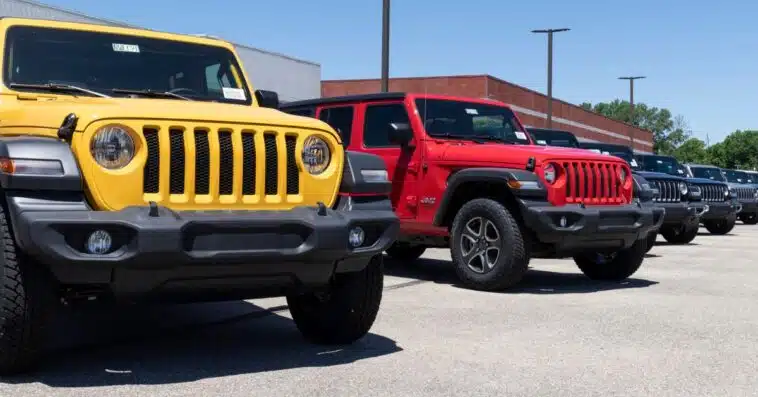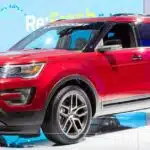Jeep Wrangler is a well-known and highly sought-after off-road vehicle that offers a unique driving experience.
This legendary SUV is known for its distinctive design, unparalleled off-road capabilities, and removable doors and top. It has a large fan following globally for its ruggedness and durability.
But do you know where are Jeep Wranglers made? The answer is the United States, specifically at the Toledo Assembly Complex in Ohio.
I’ll share the current process of the Wrangler’s production in the United States, tracing its origins to the present day.
Moreover, you can discover the intricacies of manufacturing this iconic vehicle from the assembly line to the showroom floor.
Lastly, this article will not only closely inspect the Wrangler’s headquarters but also its history as well.
So, if you want to know more about the “made in America” story of your Jeep Wrangler, stay tuned!
TABLE OF CONTENTS
Everything About The Toledo Plant In Ohio
The Toledo Plant is the heart of Jeep Wrangler production.
With a sprawling 3640000 sq. ft of manufacturing space, the plant is owned by Stellantis North America and has been in operation since the early 1910s.
The plant has a rich history of vehicle production, with Jeeps being manufactured on the site since the 1940s, during World War II.
The Toledo Plant is divided into two main facilities, Toledo North and Toledo South, including the Stickney Plant and the Parkway Annex.
The Toledo South Assembly Plant
This is the plant where the Jeep CJ was originally built, and it was upgraded in 2006 to manufacture the JK Wrangler.
The Stickney Plant
The Stickney Plant is where the assembly of the Jeep is done, and the Parkway Annex is where the painting and basic assembly is done.
Toledo Supplier Park
In 2007, Toledo South and Stickney Plant were replaced by the Toledo Supplier Park, which was opened specifically for the Jeep Wrangler.
The new facility was designed to increase efficiency and flexibility in the production process, allowing for greater output and a higher-quality final product.
History Of These Manufacturing Plants
As it has been seen in the previous sections, the Toledo Plant is home to the production of the Jeep Wrangler, but the history of the plant’s facilities is equally interesting.
The Stickney Plant is now a part of the Toledo Assembly Plant and has an interesting story.
The Stickney Plant was built in 1942 and was acquired from Autolite in 1964.
The plant was then converted for vehicle production in 1981, with the first vehicle to be built there being the Jeep Grand Wagoneer.
The Stickney Plant was renamed Toledo Assembly Plant in 1987, and many Jeep and Dodge models were manufactured there over the years.
In 2011, it was announced that a 260,000-square-foot expansion would be added to the existing body shop, and upgrades would be made to all other areas of the assembly plant.
This allowed for more production capacity and efficiency. A second production shift was also added in 2013, allowing 1100 more jobs.
That was a significant improvement, which meant that the expansion would help the local community in a way too.
As for the Jeep Wrangler, the Toledo Supplier Park was built for it in 2005. This facility focuses specifically on the body and the chassis of the Jeep. It took the place of the other factories in 2007.
Overall, the history of these plants showcases the evolution of the Wrangler production and the investment in the facilities to improve the production process, which allowed Jeep to keep producing its iconic vehicle.
The Production Process Inside The Factories
The Toledo Plant is the home of Jeep Wrangler production, where thousands of square feet of manufacturing space and cutting-edge technology are used to create 4×4.
But what exactly goes on inside the factories at Toledo?
Welding And Painting
The factory floor is where the magic happens, and the process starts with the body shop, where the body of the Jeep Wrangler is formed.
The body goes to the laser welder, where doors and other components are welded onto the frame.
After that, the Jeep is painted, with several coats applied to ensure a smooth and durable finish. A clear coating is also applied, which protects from the weather.
Engine And Electronics
Next is the general assembly line, where the powertrain, such as the engine and transmission of the Jeep Wrangler, are installed.
The addition of the lights, grilles, windshield and other final touches follows this.
An important feature of the assembly line is the Automated Guided Vehicle (AGV) which aids the workers in heavy lifting and can travel up to 150 feet per minute.
This makes the assembly process more efficient and precise and allows for a higher output of Jeeps per hour.
Finishing Touches
Finally, the wheels are installed, and the Jeep Wrangler is ready for the road.
With over 6000 employees working together in a precise, synchronized manner, the Toledo plant can produce up to 50 Jeeps per hour.
Although most of the installation process is completed by automated machinery, it would not be possible without these employees. They maintain them and ensure the quality is up to the mark.
The inside of the factories is where the various Jeep components come together to create a finished product built to last.
Thanks to the technology, automation, and hard work of the employees at Toledo, the Jeep Wrangler continues to be a beloved vehicle worldwide.
Related: Best And Worst Years For The Jeep Wrangler
Where Do Jeep Wrangler Parts Originate From?
Jeep is proud to state that 70% of the parts used in the Jeep Wrangler are made in the USA.
This means that many components that go into building the Jeep are sourced from American manufacturers, helping to support jobs and industry in the United States.
However, some parts do come from other countries.
For example, the diesel engine is sourced from Italy, and the manual transmission is imported from Germany.
This constitutes 30%, leaving behind a whopping 70% and that 70% is manufactured right here in the United States. This includes the automatic transmission and the 3.6L V6 engine.
The most famous parts of the SUV are manufactured at home, and that is something Jeep owners need to be proud of.
Despite these international components, the Jeep Wrangler is still 100% assembled in Toledo, Ohio.
Adding to this fantastic news, Fiat Chrysler announced, in 2016, that they would invest $700 million into the Toledo factory to continue Wrangler manufacturing in the United States, further solidifying the brand’s commitment to American-made products.
Overall, the Jeep Wrangler is an American icon and American-made, with most of its parts made in the USA.
The fact that the company is investing heavily in its American factory can assure the customers that it will keep producing the Wrangler with the highest quality and efficiency.
What Does The Jeep Wrangler VIN Number Tell You?
I would normally fill in this section with a breakdown of the VIN number, which would help owners of specific vehicles know more about the country of origin of their vehicles.
But, in this case, the Wrangler is only built in the United States.
Whether you find one in Europe or Canada, it originated from the Toledo, Ohio, factory.
Now the question arises, what does the VIN number help with then? Well, it does clarify many different things.
Let’s take a look:
- The first number is the country of origin. As it is the USA for all Wranglers, this will be 1.
- The second letter describes the Wrangler’s make. As it is a Jeep, this will be a J.
- The third number allows people to identify what type of vehicle. As it is an MPV, this will be a 4
- The fourth letter will allow you to see the weight range into which the Wrangler falls. G means 4000 to 5000 pounds.
- The fifth character allows you to see which Jeep it is. In the case of the Wrangler JK, it could be an A, B, E, or Z. A is for 4×4, while B is for those with a 4×2 drive. E means it was meant for export.
- The sixth character allows us to see which transmission is used. Examples are L for low line, M for medium, and P for premium.
- The body style can be confirmed with the seventh character. 4 means open body, and 9 means extended open body.
- The eighth character allows us to confirm the engine that is present. 1, 5, and 9 are the ones used in the Wrangler JK.
- 9 is the check digit, and it is there to confirm that the VIN number is not fake.
- The tenth character is the year. 7 is used for 2007, 11 is for 2011, and so on.
- 12 to 17 is the serial number of the Wrangler.
Conclusion
In a time when more and more products are being outsourced, it is heartening to see that the Jeep Wrangler is almost entirely American-made.
The factories in Toledo, Ohio, have been responsible for producing this vehicle for decades, and it is reassuring to see that they will continue to do so for many years to come.
The Jeep Wrangler is more than just a vehicle; it is a lifestyle, a symbol of freedom and adventure, and an integral part of the American fabric.
The Toledo Plant, with its history and its technological advancements, will always be the home of the Jeep Wrangler.
With that said, I hope the question of where are Jeep Wranglers made was answered. I hope you can now rest knowing about the back story of the SUV.




